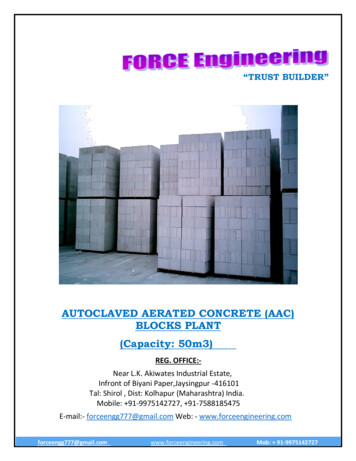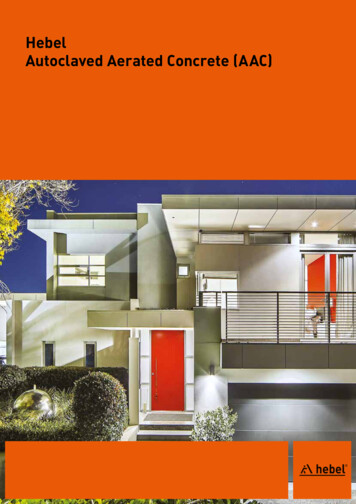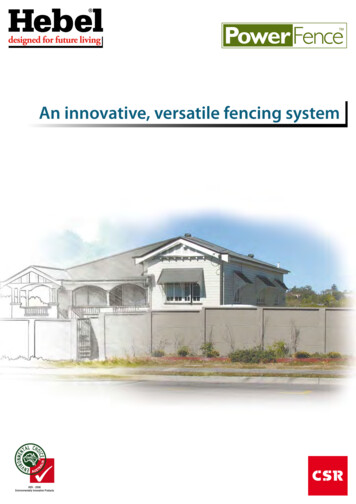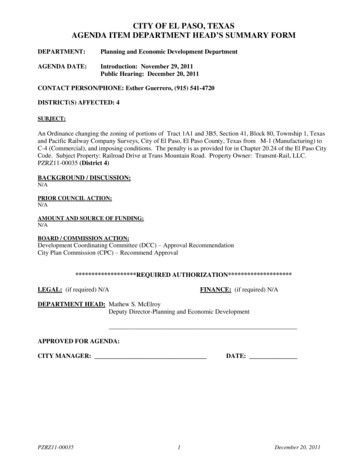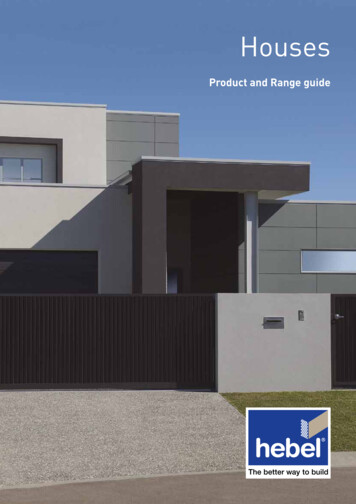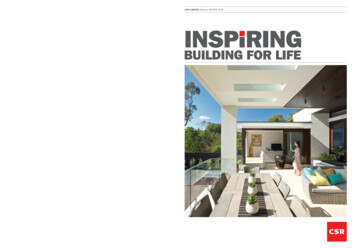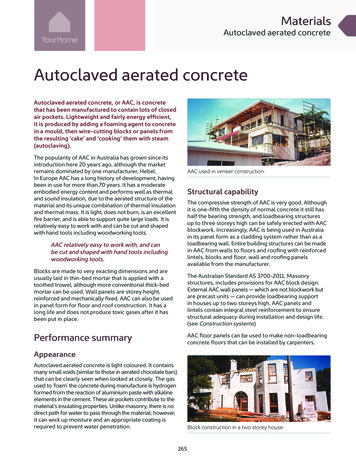
Transcription
MaterialsAutoclaved aerated concreteAutoclaved aerated concreteAutoclaved aerated concrete, or AAC, is concretethat has been manufactured to contain lots of closedair pockets. Lightweight and fairly energy efficient,it is produced by adding a foaming agent to concretein a mould, then wire-cutting blocks or panels fromthe resulting ‘cake’ and ‘cooking’ them with steam(autoclaving).The popularity of AAC in Australia has grown since itsintroduction here 20 years ago, although the marketremains dominated by one manufacturer, Hebel.In Europe AAC has a long history of development, havingbeen in use for more than 70 years. It has a moderateembodied energy content and performs well as thermaland sound insulation, due to the aerated structure of thematerial and its unique combination of thermal insulationand thermal mass. It is light, does not burn, is an excellentfire barrier, and is able to support quite large loads. It isrelatively easy to work with and can be cut and shapedwith hand tools including woodworking tools.AAC used in veneer construction.Structural capabilityThe compressive strength of AAC is very good. Althoughit is one-fifth the density of normal concrete it still hashalf the bearing strength, and loadbearing structuresup to three storeys high can be safely erected with AACblockwork. Increasingly, AAC is being used in Australiain its panel form as a cladding system rather than as aloadbearing wall. Entire building structures can be madein AAC from walls to floors and roofing with reinforcedlintels, blocks and floor, wall and roofing panelsavailable from the manufacturer.AAC relatively easy to work with, and canbe cut and shaped with hand tools includingwoodworking tools.Blocks are made to very exacting dimensions and areusually laid in thin-bed mortar that is applied with atoothed trowel, although more conventional thick-bedmortar can be used. Wall panels are storey height,reinforced and mechanically fixed. AAC can also be usedin panel form for floor and roof construction. It has along life and does not produce toxic gases after it hasbeen put in place.The Australian Standard AS 3700-2011, Masonrystructures, includes provisions for AAC block design.External AAC wall panels — which are not blockwork butare precast units — can provide loadbearing supportin houses up to two storeys high. AAC panels andlintels contain integral steel reinforcement to ensurestructural adequacy during installation and design life.(see Construction systems)Performance summaryAAC floor panels can be used to make non-loadbearingconcrete floors that can be installed by carpenters.AppearanceAutoclaved aerated concrete is light coloured. It containsmany small voids (similar to those in aerated chocolate bars)that can be clearly seen when looked at closely. The gasused to ‘foam’ the concrete during manufacture is hydrogenformed from the reaction of aluminium paste with alkalineelements in the cement. These air pockets contribute to thematerial’s insulating properties. Unlike masonry, there is nodirect path for water to pass through the material; however,it can wick up moisture and an appropriate coating isrequired to prevent water penetration.Block construction in a two storey house.265
MaterialsAutoclaved aerated concreteThermal massThe thermal mass performance of AAC is dependenton the climate in which it is used. With its mixture ofconcrete and air pockets, AAC has a moderate overalllevel of thermal mass performance. Its use for internalwalls and flooring can provide significant thermal mass.The temperature moderating thermal mass is most usefulin climates with high cooling needs. (see Thermal mass)InsulationAAC has very good thermal insulation qualities relativeto other masonry but generally needs additionalinsulation to comply with Building Code of Australia(BCA) requirements.A 200mm thick AAC wall gives an R-value rating of 1.43with 5% moisture content by weight. With a 2–3mmtexture coating and 10mm plasterboard internal lining itachieves an R rating of 1.75 (a cavity brick wall achieves0.82). The BCA requires that external walls in most climatezones must achieve a minimum total R-value of 2.8.To comply with building code provisionsfor thermal performance, a 200mmAAC blockwork wall requires additionalinsulation.Photo: Paul DowntonLoadbearing, insulating and capable of being sculpted, AAChas enormous potential as an environmentally responsiblechoice of building material.Sound insulationWith its closed air pockets, AAC can provide very goodsound insulation. As with all masonry construction, caremust be taken to avoid gaps and unfilled joints that canallow unwanted sound transmission. Combining theAAC wall with an insulated asymmetric cavity systemgives a wall excellent sound insulation properties.(see Noise control)Fire and vermin resistanceAAC is inorganic, incombustible and does not explode;it is thus well suited for fire-rated applications.Depending on the application and the thickness of theblocks or panels, fire ratings up to four hours can beachieved. AAC does not harbour or encourage vermin.Photo: Paul DowntonAAC panels on a lightweight timber framed house.A texture-coated 100mm AAC veneer on a lightweight70mm or 90mm frame filled with bulk insulationachieves a higher R rating than an otherwise equivalentbrick veneer wall. (see Insulation; Lightweight framing)Durability and moisture resistanceThe purposely lightweight nature of AAC makes itprone to impact damage. With the surface protected toresist moisture penetration it is not affected by harshclimatic conditions and does not degrade under normalatmospheric conditions. The level of maintenance requiredby the material varies with the type of finish applied.Relative to their thickness, AAC panels provide lessinsulation than AAC blockwork, e.g. a 100mm blockworkAAC wall has a dry state R-value of 0.86 and a 100mmAAC wall panel has a dry state R-value of 0.68.266
MaterialsAutoclaved aerated concreteThe porous nature of AAC can allow moisture topenetrate to a depth but appropriate design (damp proofcourse layers and appropriate coating systems) preventsthis happening. AAC does not easily degrade structurallywhen exposed to moisture, but its thermal performancemay suffer.taken not to trap moisture where it can condense, AACmay be an ideal material for homes for the chemicallysensitive.A number of proprietary finishes (including acrylicpolymer based texture coatings) give durable andwater resistant coatings to AAC blockwork and panels.They need to be treated in a similar fashion with acrylicpolymer based coatings before tiling in wet areassuch as showers. The manufacturer can advise on theappropriate coating system, surface preparation andinstallation instructions to give good water repellentproperties.Photo: Paul DowntonAutoclaved aerated concrete is about one-fifth the densityof normal concrete blocks.Environmental impactsWeight for weight, AAC has manufacturing, embodiedenergy and greenhouse gas emission impacts similarto those of concrete, but can be up to one-quarter toone-fifth that of concrete based on volume. AAC productsor building solutions may have lower embodied energyper square metre than a concrete alternative. In addition,AAC’s much higher insulation value reduces heatingand cooling energy consumption. AAC has somesignificant environmental advantages over conventionalconstruction materials, addressing longevity, insulationand structural demands in one material. As an energy andmaterial investment it can often be justified for buildingsintended to have a long life. (see Material use)Offcuts from construction can be returned to themanufacturer for recycling, or be sent out as concretewaste for reuse in aggregates; alternatively, the oddpieces can be used directly for making, for example,garden walls or landscape features.Photo: Paul DowntonPlasticised, thin coat finishes are common, but here anon-plasticised thick coat render (10mm approximately)was used. Some variation in the amount of show-throughof the blockwork pattern can be seen in this example,which also illustrates the use of glass blocks as well as moreconventional windows.Toxicity and breathabilityThe aerated nature of AAC facilitates breathability.There are no toxic substances and no odour in the finalproduct. However, AAC is a concrete product and callsfor precautions similar to those for handling and cuttingconcrete products. It is advisable to wear personalprotective equipment such as gloves, eye wear andrespiratory masks during cutting, due to the fine dustproduced by concrete products. If low-toxic, vapourpermeable coatings are used on the walls and care isPhoto: Paul DowntonThe clear difference between the lower and higher courseof blockwork in the loadbearing AAC walls of an apartmentbuilding under construction shows the difference in qualitythat can be achieved with the same material by differentlyskilled tradespeople.267
MaterialsAutoclaved aerated concreteBuildability, availability and costbuilders time and money, and help achieve environmentalperformance objectives. All masonry construction has tocomply with the BCA and relevant Australian Standards,e.g. all masonry walls are required to have movement orexpansion joints at specified intervals.Although AAC is relatively easy to work, is one-fifththe weight of concrete, comes in a variety of sizesand is easily carved, cut and sculpted, it neverthelessrequires careful and accurate placement: skilledtrades and good supervision are essential. Competentbricklayers or carpenters can work successfully withAAC but dimensional tolerances are very small whenblockwork is laid with thin-bed mortar. Thick-bed mortaris more forgiving but is uncommon and not the industrypreferred option. Very large block sizes may requiretwo-handed lifting and be awkward to handle but canresult in fewer joints and more rapid construction.The standard block size is 200mm high by 600mm long.Block thickness can range from 50mm to 300mm butfor residential construction the most common blockwidths used are 100mm, 150mm and 200mm. AACblocks can be used in a similar manner to traditionalmasonry units such as bricks: they can be applied as aveneer in timber frame or serve as one or both skinsin cavity wall construction.The construction process with AAC produces little wasteas blockwork offcuts can be reused in wall construction.Good design that responds to the regime of standardisedpanel sizes encourages low-waste, resource-efficientAAC panel construction.The standard panel size is 600mm wide by 75mm thickwith lengths ranging from 1200mm to 3000mm. AACpanels can be used as a veneer cladding over timber orsteel-framed construction. (see Lightweight framing)The AAC manufacturer provides a wealth of detailedtechnical advice that, if followed, should help to ensuresuccessful use of the product.The cost of AAC is moderate to high. In Australia, AAC iscompetitive with other masonry construction but moreexpensive than timber frame. Lack of competition in themarketplace makes consumers highly dependent on onemanufacturer.Movement jointsMovement joints must be provided at 6m horizontalcentres maximum (measured continuously around rigidcorners). Refer to the manufacturer’s guidelines forfurther information.FootingsAAC block construction requires level footings designedfor full or articulated masonry in accordance with AS2870-2011, Residential slabs and footings. Stiff footingsare preferred because the wall structure of thin-bedmortar AAC acts as if it were a continuous material andcracking tends not to follow the mortar beds and jointsthe way it does in traditional masonry walling. Thick-bedmortar AAC walls act more like traditional masonry butare not the preferred method for AAC.Source: AACThis isometric concept shows the versatility of AAC productsin dwelling construction.FramesFrames may be required for various structural reasons.Earthquake provisions tend to require multi-storey AACstructures to have a frame of steel or reinforcement towithstand potential earthquake loads that may inducestrong, sharp horizontal forces. It is a relatively simplematter to build AAC blockwork around steel framesbut embedding reinforcement rods can be costly anddifficult.Typical domestic constructionConstruction processAll structural design should be prepared by a competentperson, and may require preparation and approval by aqualified engineer. Qualified professionals, architectsand designers bring years of experience and access tointellectual property that has the potential to save house268
MaterialsAutoclaved aerated concreteor curved for visual effect and you can easily makechannels for pipes and wires with an electric router.Use appropriate dust reduction strategies with allcarving and cutting, and wear appropriate personalprotection equipment at all times.Photo: Paul DowntonAAC panels on lightweight steel framed houses.Joints and connectionsThe AAC manufacturer provides proprietary mortarmixes. Although more conventional thick-bed mortar(approximately 10mm) can be used with AAC, themanufacturer’s approved option is a proprietarythin-bed mortar. With this method, the procedure oflaying the blocks is more like gluing than conventionalbrickwork construction. This is why many traditionallytrained bricklayers may need some time to adjust to thisdifferent method of working. In addition, brickies areused to lifting bricks with a single hand and AAC blocksoften require two-handed manipulation. Although thismay appear a slower construction process than layingmasonry units, an AAC block is equivalent to five or sixstandard bricks.Photo: Paul DowntonThis dry-lined interior shows how AAC can be exploited tomake niches and unusual openings.FinishesAAC blockwork and panels can accept cement render,but the manufacturer recommends using a proprietaryrender mix compatible with the AAC material substrate.Site-mixed cement renders have to be compatible withthe AAC substrate, with the render having a lower strengththan conventional renders. All renders should be vapourpermeable (but water-resistant) to achieve a healthybreathable construction. All external coating finishesshould provide good UV resistance, be vapour permeableand be proven suitable for AAC. Consult the manufacturer’sliterature for further information on coatings.Loadbearing wallsAAC is available in blocks of various sizes and in largerreinforced panels, sold as part of a complete buildingsystem that includes floor and roof panels, and interiorand exterior walls.References and further readingAroni, S. 1993. Autoclaved aerated concrete: properties, testingand design: RILEM recommended practice. RILEM TechnicalCommittees 78-MCA and 51-ALC. E & FN Spon, London.FixingsAAC has low compression strength. The use ofmechanical fasteners is not recommended, as repeatedloading of the fastener can result in local crushing ofthe AAC and loosening of the fastener. Proprietaryfasteners are specifically designed to accommodate thenature of the material by spreading the forces createdby any given load, whether it is a beam, shelf or picturehook. A number of proprietary fixings for AAC comewith extensive guidance in product literature. If youare not sure, consult the project engineer or fastenermanufacturer for guidance.Comité Euro-International du Béton and Bave, G. 1978.Autoclaved aerated concrete: CEB manual of design andtechnology. Construction Press, Lancaster, UK.CSR. 2006. CSR Hebel technical manual. http://hebel.com.auLawson, B. 1996. Building materials, energy and theenvironment: towards ecologically sustainable development.Royal Australian Institute of Architects, Red Hill, ACT.Staines, A. 1993. Australian house building the easy Hebel way,2nd edn. Pinedale Press, Caloundra, Qld.OpeningsAuthorAAC is soft enough to be cut with hand tools. Niches canbe carved into thicker walls, corners can be chamferedAuthor: Paul DowntonUpdated 2013269
All masonry construction has to comply with the BCA and relevant Australian Standards, e.g. all masonry walls are required to have movement or expansion joints at specified intervals. The standard block size is 200mm high by 600mm long. Block thickness can range from 50mm to 300mm but for residential construction the most common block
